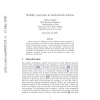Free Online Productivity Tools
i2Speak
i2Symbol
i2OCR
iTex2Img
iWeb2Print
iWeb2Shot
i2Type
iPdf2Split
iPdf2Merge
i2Bopomofo
i2Arabic
i2Style
i2Image
i2PDF
iLatex2Rtf
Sci2ools
NIPS
2000
2000
Stability and Noise in Biochemical Switches
Many processes in biology, from the regulation of gene expression in bacteria to memory in the brain, involve switches constructed from networks of biochemical reactions. Crucial molecules are present in small numbers, raising questions about noise and stability. Analysis of noise in simple reaction schemes indicates that switches stable for years and switchable in milliseconds can be built from fewer than one hundred molecules. Prospects for direct tests of this prediction, as well as implications, are discussed.
| Added | 01 Nov 2010 |
| Updated | 01 Nov 2010 |
| Type | Conference |
| Year | 2000 |
| Where | NIPS |
| Authors | William Bialek |
Comments (0)

